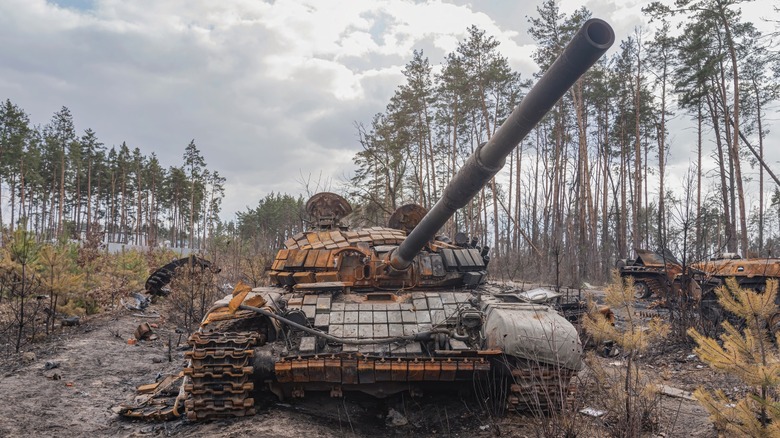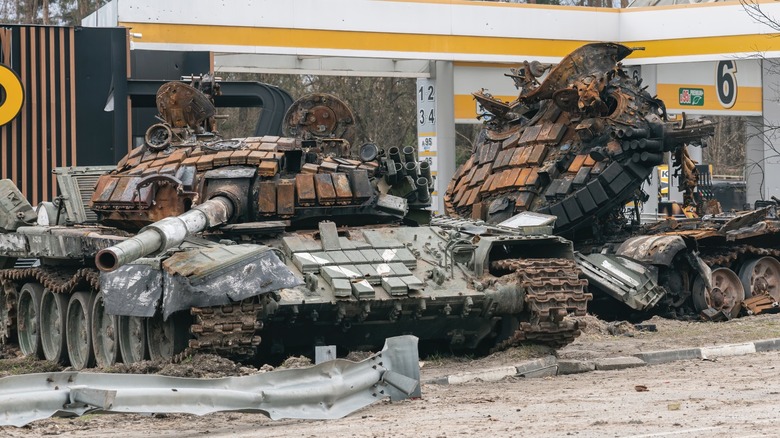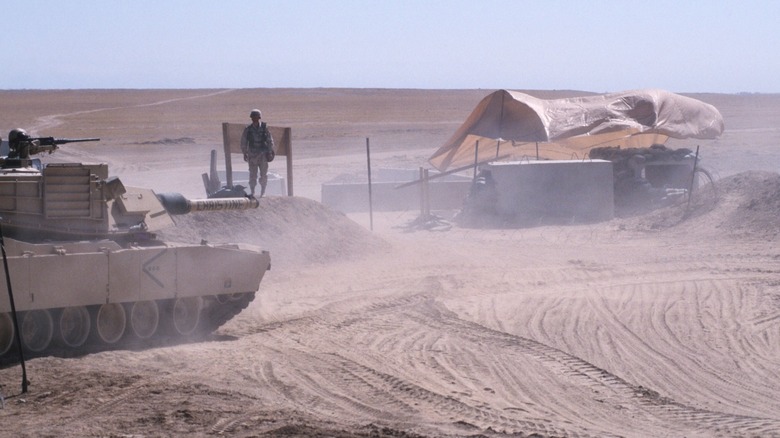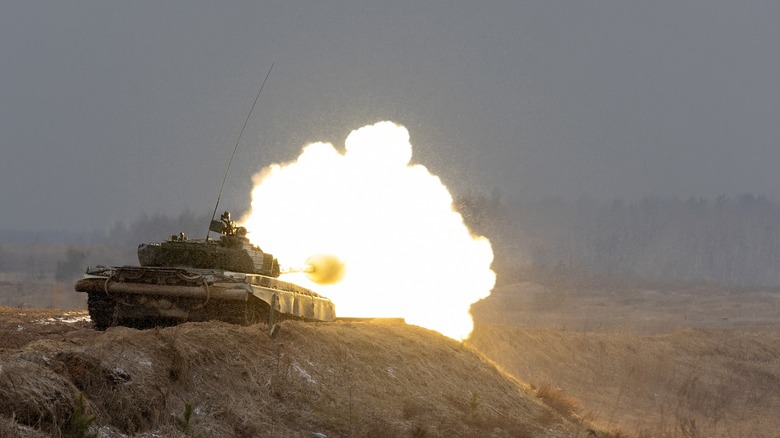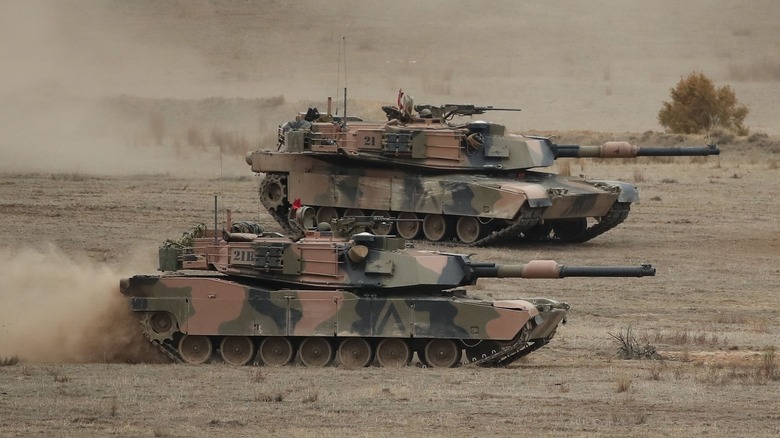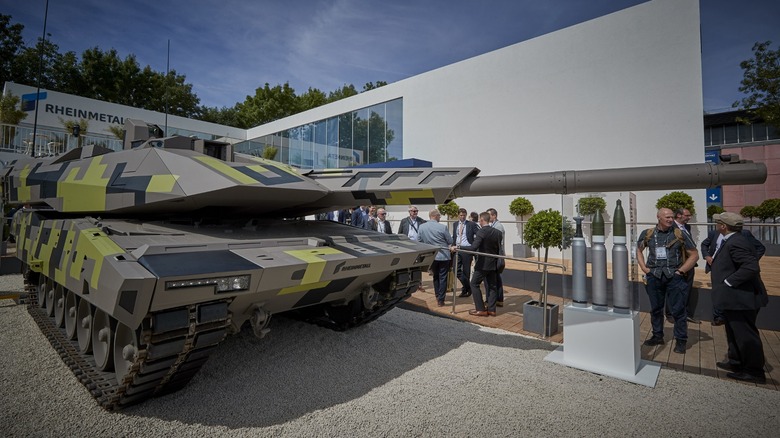The Role Of Tanks In Modern Military Operations: Are They Becoming Obsolete?
Massive Russian tank losses during the opening days of its invasion of Ukraine has caused people to believe that the tank has started to become obsolete. Less than two years prior to the Russian invasion, Armenia saw its $1.2 million T-72 tanks get disabled by a $105,000 SkyStriker drones from Azerbaijan. More recently, Ukraine ordered those same drones. While the company nor the customer didn't say where it would use those weapons, it won't be hard to imagine where they would be deployed.
Because of news like these, it's easy for us to say that the tank has reached its heyday and is on the way out of modern armies, especially with the numerous videos of drones taking out tanks on social media. However, these videos may not totally represent the actual events on the ground. In fact, the majority of tank losses that Russia suffered happened during its initial incursion into Ukraine, when its efforts were still disorganized.
Although new technologies like drones and Javelin anti-tank missiles have brought new challenges to armored warfare, they haven't phased out the tank on the battlefield. Let's dive into the reasons why people think tanks are obsolete and why this is untrue.
Tanks aren't invincible
One of the biggest misconceptions most people have about a tank is that it's a giant metal monster impervious to enemy fire. However, that is not the case — while tanks can withstand small arm fires, they are vulnerable to larger ammunition like artillery, rockets, and missiles.
Even the vaunted American M1 Abrams, British Challenger 2, and German Leopard 2 tanks that Ukraine deployed to its battlefields were destroyed by Russian-made drones. But if you look at tank losses — on both the Russian and Ukrainian sides — they're usually armored units that have been separated from or have no other units with them or lacked a sufficient number of infantry soldiers to protect them.
That is why tanks aren't meant to be employed as a single unit. Instead, they should be deployed with other units, like mechanized infantry, air defense, artillery, and even special reconnaissance teams, to act as one coherent force.
Combined arms tactics are the best use of tanks
Tanks have been around for over a hundred years, with the first tanks to see combat entering service between 1916 and 1918. But. it was the Second World War that saw the first widespread use of tanks in combat when Germany employed the Blitzkrieg strategy to overwhelm Poland and France. Even at the Battle of Kursk, the Germans used combined-arms tactics to give their smaller army an advantage over the Soviets. However, the Russian defenders used their own combined-arms strategy to defeat the feared Tiger Tank and Ferdinand Tank Destroyers the Nazis fielded.
As proven in the battlefields of Europe, tanks are most effective when used in combination with other units — especially supporting infantry to protect them against ambushes and the required logistical train to keep them running. Russia's initial losses in Ukraine were primarily because of logistical issues, which led many operators to abandon their vehicles when they broke down in enemy lines.
Other tanks that were destroyed in combat were often left exposed to the enemy because they were beyond artillery and air defense coverage. Enemy infantry could stealthily move in and pick off these huge, slow, metal targets one by one, using either man-portable anti-tank missiles like the American Javelin or British NLAW, loitering munitions like the Switchblade or SkyStriker, or even DIY drones made using commercial systems with large explosives strapped on them.
Tanks will punch through entrenched enemy positions
With tanks requiring so much protection and logistics, why do armies still field them in battle? Because these armored vehicles provide infantry companies with deadly firepower that can take a beating and can move around the battlefield relatively quickly.
Many successful historical offensives have been spearheaded by tank formations — from Israel's spearhead into the Sinai Peninsula during the 1967 Six-Day War to America's use of M1 Abrams tanks on its assault on Baghdad in its 2003 Operation Iraqi Freedom. This has been true even during World War 2, when armored formations worked closely alongside infantry, artillery, and reconnaissance elements during the American assault on Aachen, allowing them to capture the city despite having limited infantry resources.
The U.S. repeated this during the Korean War, when American forces attempted to liberate Seoul in 1950. Initial assaults were repelled by the occupying North Koreans, with correspondingly high losses. So, they brought in tanks to support their following attempts at dislodging the enemy. This attempt was successful, as a tank could roll up and dispatch entrenched enemy positions with quick and accurate fire, while its crew stays protected behind its armored hull. This would allow an assault to move forward quickly instead of requiring vulnerable infantry to find flanking routes to bypass defenses.
You must use proper doctrine to successfully deploy tanks
The Second Nagorno-Karabakh War is another post-2020 conflict that showed how proper combat doctrine allowed for the successful use of tanks in the battlefield. Armenia and the Nagorno-Karabakh Republic lost a massive number of tanks to Turkish Bayraktar TB2 drones, one of the best military drones flown by armed forces in 2024, operated by Azerbaijan.
However, these Azerbaijani drones had free reign on Armenia's tanks after the former destroyed a huge chunk of the latter's air defenses. When bad weather grounded the Bayraktar TB2s, Armenia was able to use its tanks for massive counterattacks. With Armenian tanks suppressed for much of the war, the Azerbaijan armed forces had free reign to wreak havoc and break through Armenian defenses.
While many might say that this is proof that tanks aren't effective anymore, we must remember that tanks are nothing but tools of war. Its presence will dictate the course of victory, as shown in the Armenia-Azerbaijan conflict, when the former lost its ability to protect its tanks, which contributed to further losses.
Tanks still have a place in modern warfare
Tanks, just like jets, ships, artillery, and other tools of war, have proper use. Even if you have the most modern weapons and the best tanks, you can still lose a conflict if you don't have the correct strategy and support — just like how North Vietnam caused heavy losses to the United States in the Vietnam War.
A tank brings mobile firepower and armored protection to the battlefield, and even a single tank can defeat many infantry units if they are unprepared. But you're risking a multi-million-dollar asset if you don't deploy a tank with the support it requires, especially as its capability makes it a prime target for anti-tank forces. This was true ever since the first tanks were fielded in the Great War, like when a British Mark IV tank named Fray Bentos was lost after the tank got stuck in a ditch. Another more recent example is when Houthi rebels in Yemen were able to destroy a Saudi M1A2S Abrams main battle tank after its track was disabled.
But when used with the proper infantry, artillery, anti-air, and air support, tanks could be the clenched fist of a well-rounded combined arms assault. We've seen this when Azerbaijan used new technologies to destroy Armenian armor. It's also the reason why countries that vie for regional power like China, India, Japan, South Korea, and Taiwan have been stocking up on them, too: not only do they serve as effective combat weapons when deployed effectively, but they also serve as a deterrent to other nations, as armored brigades could hamper any offensive operation and complicate an invasion.
